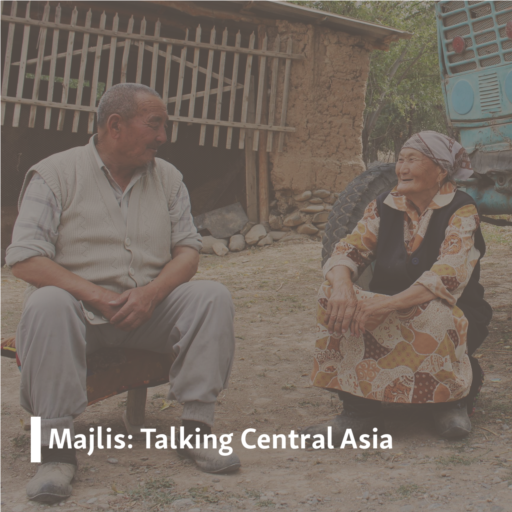The residents of Tut, a village of cattle breeders and farmers in Uzbekistan’s highlands, have long depended on the Shovvozsoy River for their drinking water, irrigation, and livestock.
But in the summer of 2018, the Shovvozsoy -- which begins in the mountains of Kyrgyzstan and flows down into the Angren River in Uzbekistan’s Tashkent region -- slowed to a trickle, according to several villagers.
“Our crops and orchards dried up,” one local in Tut, which is located at the lower end of the Shovvozsoy, told RFE/RL’s Uzbek Service. “We had to survive by buying water from neighboring villages.”
The cause of the water stoppage wasn’t a mystery to locals. Some 18 kilometers upriver, a new dam and reservoir had been built in the mountains. Next to the reservoir, one Tut resident said, a “small city” was being built “with hundreds of permanent employees where locals can’t even get close.”
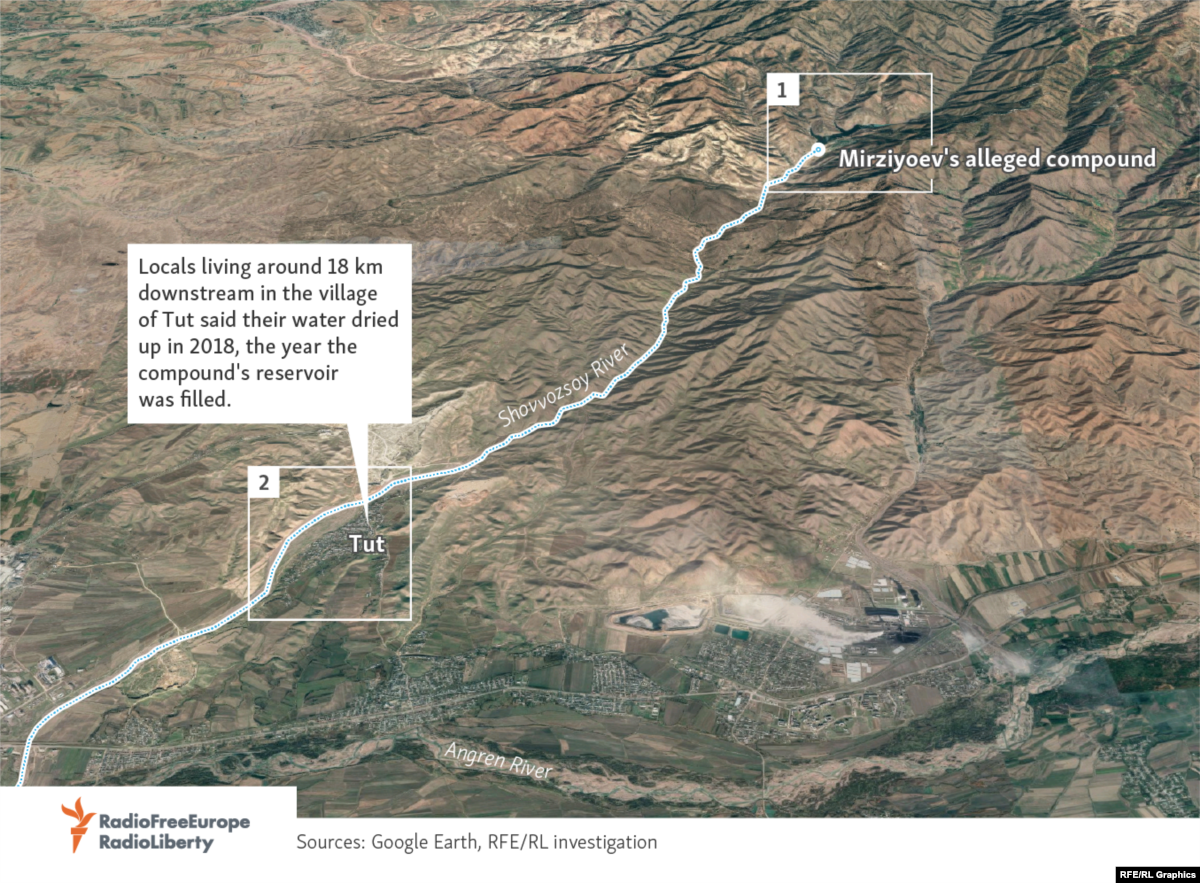
The “small city” in question is a secretive mountain resort that a new multipart investigation by RFE/RL’s Uzbek Service has found was built on protected land for the use of Uzbek President Shavkat Mirziyoev.
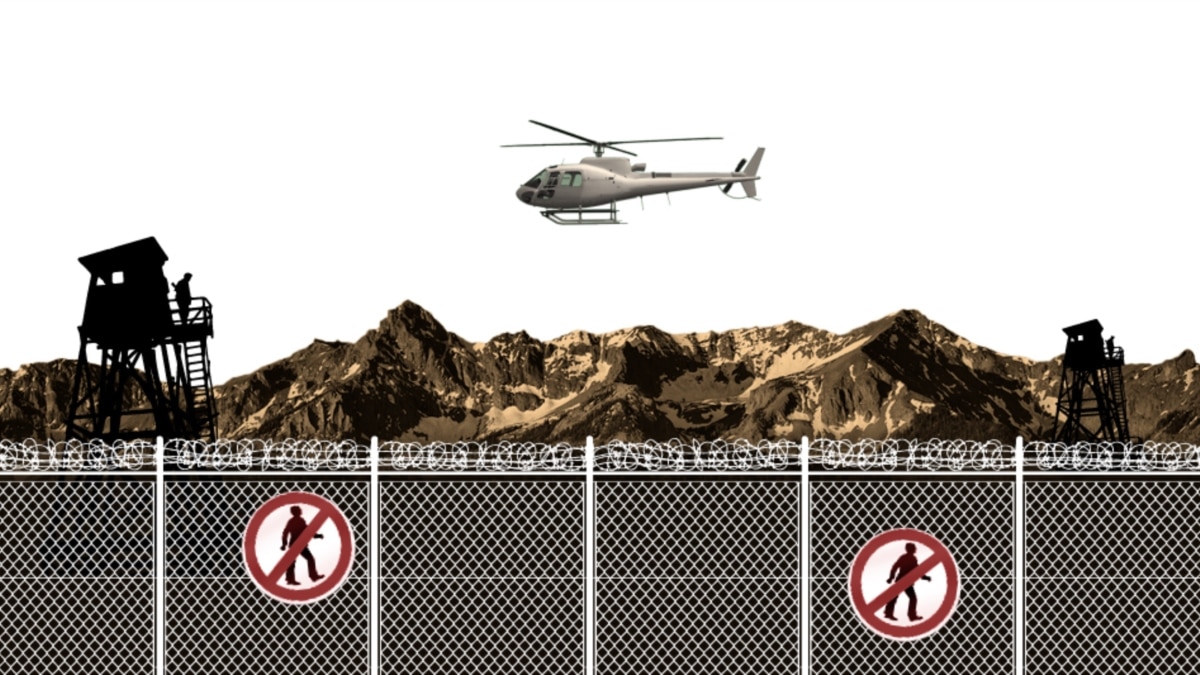
A 'Classified' Uzbek Resort Fit For A President
The Uzbek government has never disclosed the cost or purpose of a sprawling, secretive resort that locals refer to as the "dacha" of President Shavkat Mirziyoev. A new investigation suggests it might have cost hundreds of millions of dollars.
The resort -- which features helicopter pads, a no-fly zone, and what sources described as a luxurious mansion for Mirziyoev -- is shrouded in secrecy. Construction workers said they were forced to hand over their phones, and roadblocks and security guards prevent the public from approaching.
Comparably mysterious is the reservoir, directly adjacent to the compound, that villagers in Tut say halted their water supply beginning in the summer of 2018.
Reporters were able to locate just one official document -- a state-owned contractor’s business plan -- explicitly mentioning the reservoir. That document suggests the reservoir was built in line with a Mirziyoev decree on expanding hydropower. That decree includes several projects mentioned in the business plan, but not the Shovvozsoy reservoir.
But the investigation by RFE/RL’s Uzbek Service found evidence linking its construction to the same players behind the Sardoba Dam, which burst in May 2020, leaving six dead and forcing at least 70,000 from their homes in Uzbekistan’s eastern Sirdaryo region.
It’s unclear from publicly available records what risk analysis was undertaken prior to construction of the Shovvozsoy reservoir. Two sources said that the dam built at the site suffered a leak in 2019.
It’s also unclear exactly how construction of the reservoir, which displaced longtime residents living on the banks of the Shovvozsoy River, was legally reconciled with the protected status of the land on which it was built.
Such a project “would disrupt the local habitat significantly,” one international water-use expert who has worked in Central Asia told RFE/RL’s Uzbek Service.
“Therefore, before construction of such an object in a river system, a proper social and environmental impact study as well as hazard and risk analysis are supposed to be carried out,” the expert said on condition of anonymity.
All of the sources interviewed for this report did so on condition of anonymity, citing lack of authorization from their employers to speak to the media or fears of retribution from authorities.
Neither Mirziyoev’s office nor Uzbekistan Railways, the state-owned company that controls the land on which the resort and reservoir are located, responded to requests for comment.
A Reservoir Runs Through It
Multiple sources, including construction workers and officials, told RFE/RL’s Uzbek Service that construction of the Shovvozsoy resort and adjacent reservoir began in 2017 and took about three years to complete. While the site is protected by roadblocks and security personnel, satellite imagery corroborates that account.
Satellite imagery also shows that construction of the dam that would create the reservoir was already under way by July 2017, and that the reservoir was being filled by early April 2018. The following month Mirziyoev’s prime minister, Abdulla Aripov, formally created the Ugam-Chatkal State Biosphere Reserve -- a 43,000-hectare territory on which the reservoir and compound sit -- and placed it under control of Uzbekistan Railways, the state-owned company headed at the time by Achilboy Ramatov, now the first deputy prime minister.
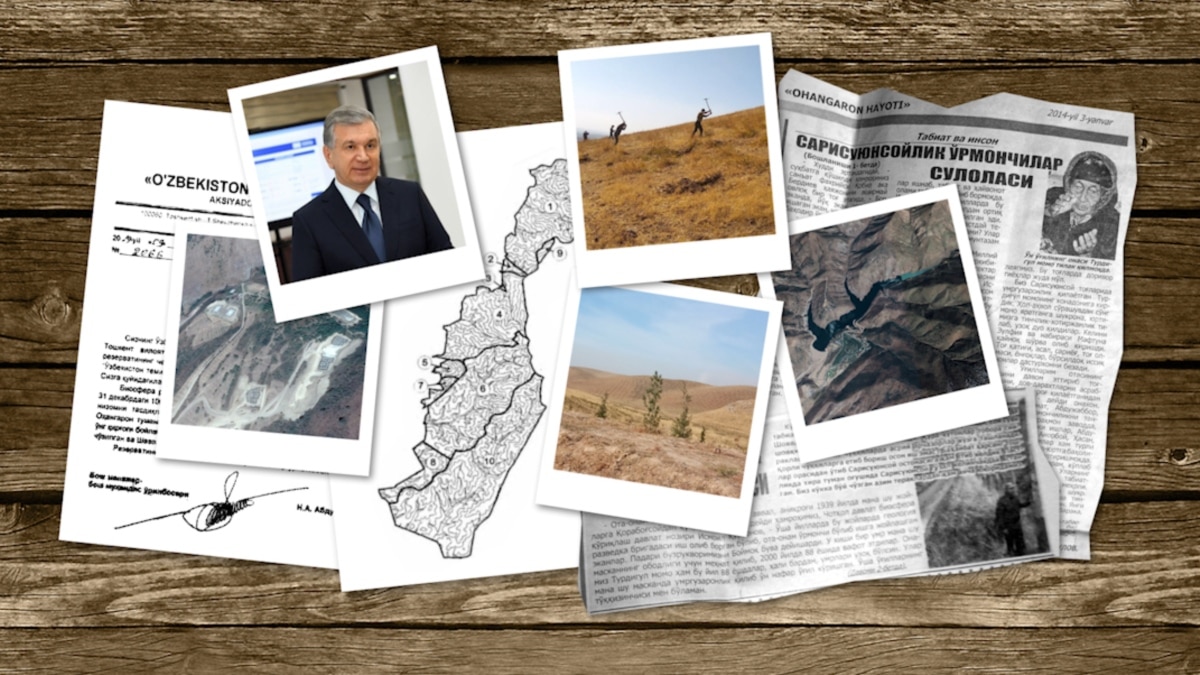
The Displaced 'Guardians' Of An Idyllic Uzbek Valley
A family in an idyllic gorge of the Uzbek highlands was known for its stewardship of the area for decades. Then came the secretive development of an exclusive resort linked to the country's president.
It was in the ensuing months, as the surface area and volume of the reservoir grew, that downstream residents in the village of Tut say the river on which they depended dried up.
“Since 2018, only once or twice in the spring have they let the water trickle down to the village,” one Tut resident said. “Even then, the big farmers at the top took it and didn't give water to the people below."
Several villagers said locals appealed to the local “hokimiyat” (regional administration).
“Even though people went to all levels of the hokimiyat to complain and demand water, they still could not bring water,” the Tut resident said.
One source familiar with the construction in Shovvozsoy claimed to RFE/RL’s Uzbek Service that the reservoir was the brainchild of Abdugani Sanginov, a wealthy senator and loyal ally of Mirziyoev who heads the state-owned UzbekHydroEnergo.
The source claimed that the main purpose of the reservoir was to beautify the Shovvozsoy resort for Mirziyoev’s use, though reporters were unable to corroborate this account.
“A separate dock was built to walk and enjoy the close view,” the source said.
As early as July 2019, satellite imagery shows a house with what appears to be a dock on the southern bank of the reservoir, 300 meters from what sources described as a hunting lodge.
The water-use expert with experience in Central Asia said such reservoirs could be used for irrigation, water supply, hydropower, and “groundwater recharge.” He said he doesn’t believe that such a reservoir “can be justified by its usability only for recreational purposes.”
“The reservoir must serve a social purpose as well. That is even more important,” he said.
A Lake With No Name
More than two years have passed since construction of the reservoir next to the secretive mountain compound began. But reporters located just a single official record identifying the body of water by name or location.
In its business plan for 2019, Gidromaxsusqurilish -- a subsidiary of state-owned UzbekHydroEnergy -- listed among its “main events” for 2017 and 2018 “the construction of the Shovvozsoy reservoir.”

The document suggests the reservoir was one of several the company built in line with a May 2017 decree by Mirziyoev on the expansion of hydropower in Uzbekistan. But while several of the projects in the Gidromaxsusqurilish business plan are listed in that decree, the Shovvozsoy reservoir is not. (The reservoir is also not listed on the section of the company’s website featuring projects it has completed or participated in.)
Gidromaxsusqurilish’s business plan states that it acquired equipment in 2018 using 11.9 billion Uzbek soms ($1.1 million at the time) in loans thanks to a decree by Mirziyoev in February of that year. That same decree allocated $60 million from the state Fund For Reconstruction And Development Of Uzbekistan to state-owned Turonbank to be used as credit lines for UzbekHydroEnergo entities, which include Gidromaxsusqurilish.
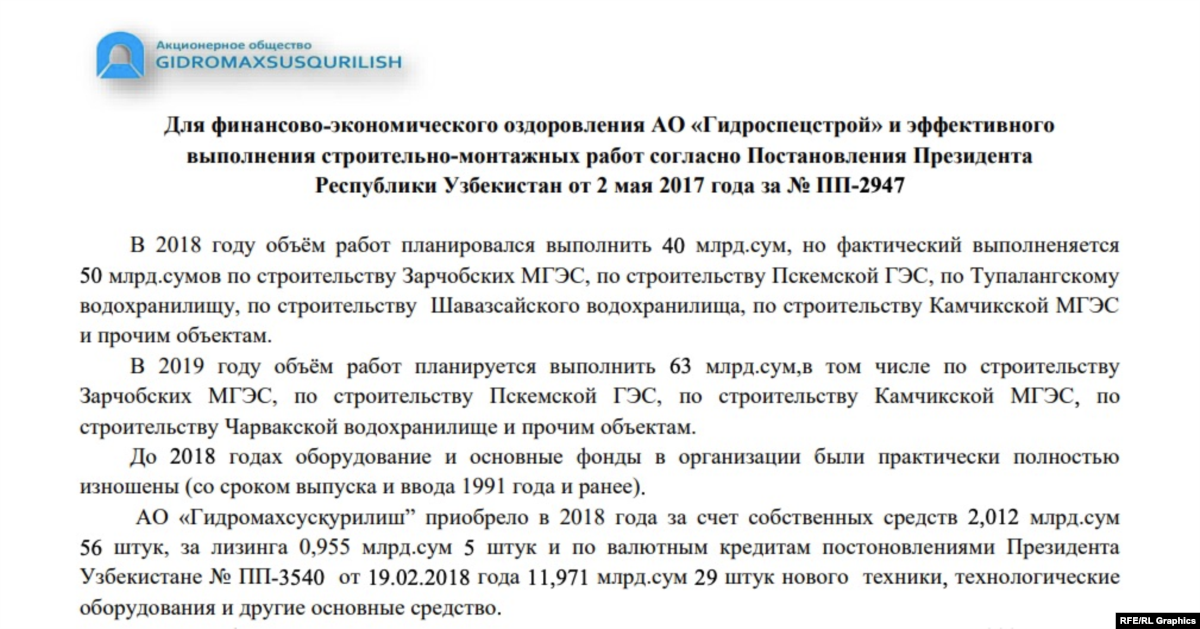
The trio tasked with overseeing the 2018 decree includes the chairman of UzbekHydroEnergo, Abdugani Sanginov -- the wealthy senator who, as one source claimed to RFE/RL’s Uzbek Service, allegedly conceived of the plan to build the reservoir next to the Shovvozsoy resort.
Sanginov did not respond to a request for comment. But UzbekHydroEnergo, whose subsidiaries’ public financial disclosures indicated their work on the Shovvozsoy site, denied any connection to the reservoir.
“Our company has nothing to do with the construction of the Shovvozsoy reservoir,” UzbekHydroEnergo said in a February 22 e-mailed statement to RFE/RL, adding that the company also does not know the purpose of the reservoir.
“Our company was not responsible for, nor did it participate in, the construction of this facility,” the statement said. “Also, we would like to inform you that we are not involved in the operation and control of this reservoir.”
Publicly available corporate disclosures show, however, that around the time the Shovvozsoy reservoir was being filled in the summer of 2018, a flurry of contracts were signed involving UzbekHydroEnergo, its subsidiary Gidromaxsusqurilish, Turonbank, and a private firm owned by Sanginov’s son.
Sanginov is a key figure in the planning and construction of hydro projects in Uzbekistan. His youngest son, Islom Abdurahmonov, is the main shareholder of Topalang HPD Holding, a privately held Uzbek company.
Multiple sources, including one individual with direct knowledge of the matter, told RFE/RL’s Uzbek Service that the reservoir was built by Topalang Water Construction, which built the Sardoba Dam that collapsed in May 2020. Topalang Water Construction is a 100 percent subsidiary of Abdurahmonov’s Topalang HPD Holding.
The 2018 annual report of the Sanginov-chaired UzbekHydroEnergo does not include an overt reference to the dam and reservoir built at Mirziyoev’s retreat. But it does mention five “loan contracts” signed with Topalang HPD Holding in May 2018 -- a month after satellite images show the reservoir being filled.
Turonbank, which Mirziyoev’s decree granted $60 million for credit lines to UzbekHydroEnergo entities, is listed as a counterparty in these loans.
Neither UzbekHydroEnergo nor Topalang HPD Holding responded to requests for comment on the purpose of these loans, whose total was listed at 269.4 billion Uzbek soms ($33.6 million at the time).
But that sum is consistent with an estimate given by a source familiar with the reservoir’s construction who claimed the project cost the state budget more than 200 billion Uzbek soms.

Corroborating evidence of Topalang’s involvement came from an UzbekHydroEnergo manager, who told an independent Tashkent-based activist in November that the reservoir was built by Topalang Water Construction.
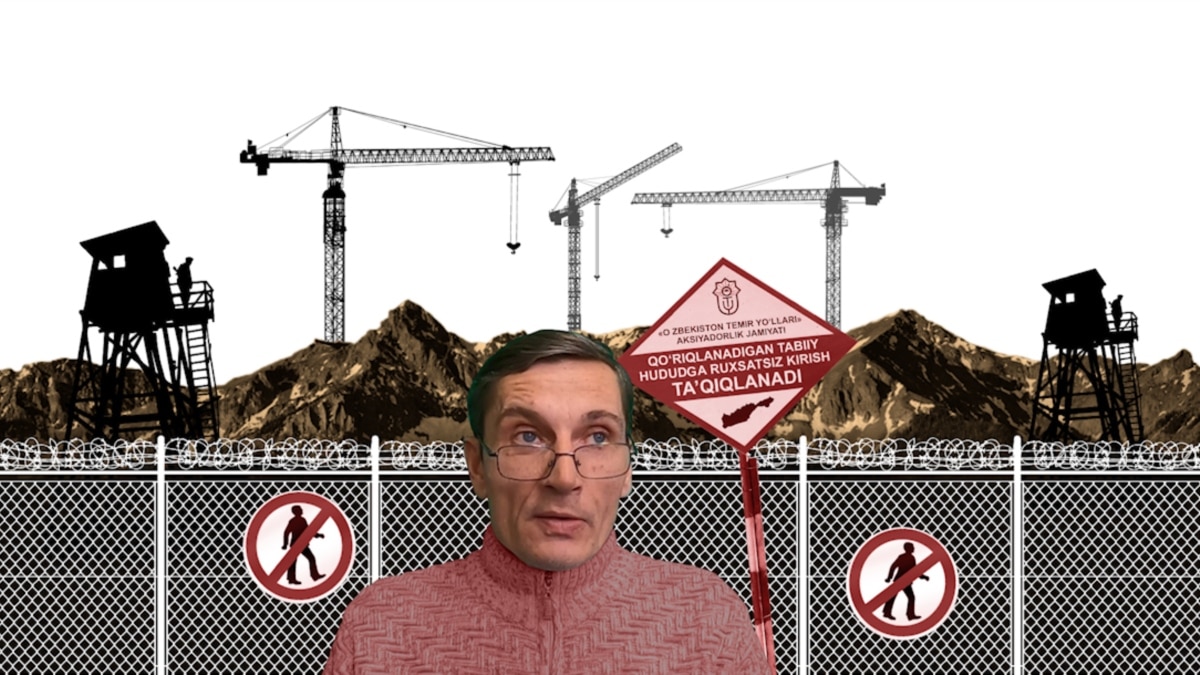
'Our Father's Dacha': How An Uzbek Activist Sniffed Out The President's 'Secret'
When Uzbek activist Aleksei Garshin asked a manager at the state-owned contractor about a clandestine mountain resort linked to President Shavkat Mirziyoev, he was told its construction had been "classified as secret."
The same day as UzbekHydroEnergo signed the first of its five contracts with Topalang HPD Holding for an unspecified purpose, it also signed a contract with its subsidiary Gidromaxsusqurilish -- the company whose business plan featured the only official mention of the Shovvozsoy reservoir that reporters could find.
Under that contract, UzbekHydroEnergo signed a loan agreement with Gidromaxsusqurilish worth 40 billion Uzbek soms ($5 million at the time) for unspecified services. Turonbank was listed as a counterparty in that loan as well, UzbekHydroEnergo’s 2018 annual report shows.
The contracts with Gidromaxsusqurilish and Topalang HPD Holding that UzbekHydroEnergo listed in its 2018 annual report -- and which were signed around the time of the Shovvozsoy reservoir’s construction -- total 309.4 billion Uzbek soms ($38.7 million at the time).
But because the annual report does not identify the nature of the services related to these contracts, it could not be confirmed with absolute certainty that the contracts were related to the Shovvozsoy reservoir.
A spokesman for the Uzbek Water Resources Ministry, which oversees all canals and reservoirs in the country, told a reporter that the Shovvozsoy reservoir does not fall under the auspices of the ministry.
“We have two reservoirs in the Tashkent region. One is the Tashkent [reservoir], and the other is the Ohangaron reservoir,” the spokesman said in a written response. “If you like, we can provide information about these two reservoirs.”
A search for the Shovvozsoy reservoir on the ministry’s website, as well as that of the National Center for Geodesy and Cartography, yielded no results.
There is also no mention of the reservoir in a 2020 UN European Economic Commission report on environmental activities in Uzbekistan.
The report, which is based on data provided by the Uzbek government, states that the Water Resources Ministry did not issue any permits for special use of water in 2017-18 -- a period covering the construction of the Shovvozsoy reservoir.
A man who identified himself as Topalang Water Construction’s chief accountant told a reporter that the company served as the “general contractor” of the Shovvozsoy reservoir but that any questions about the project should be referred to Uzbekistan Railways’ capital-construction department.
“They are the owners of the facility. Whether they will give you any information about it, I am not sure, because it is a very strategic object,” the man, who gave his name as Hayitmurod Hasanov, told the reporter in a phone conversation.
Asked to clarify what he meant by “strategic object,” Hasanov replied: “I can’t tell you these things.”
Echoes Of Sardoba
One individual who has inspected the Shovvozsoy site said he had seen official documents showing that the dam is 70 meters high and that the reservoir’s volume is around 50-60 million cubic meters, though reporters could not corroborate this.
Two sources told RFE/RL’s Uzbek Service independently of one another that the dam suffered a leak in 2019.
“The leakage in Shovvozsoy was before Sardoba and actually was a signal of upcoming disaster in a way,” one of the sources said, referring to the May 2020 dam collapse that left six people dead and forced thousands to flee their homes.
Residents of the village of Tut, 18 kilometers downstream from the Shovvozsoy resort, say it’s not only the reservoir that disrupted their lives.
Dozens of houses were demolished to widen the road leading to the compound, and pasture lands were confiscated for the project, they said.
“The only source of income for villagers is cattle breeding,” one Tut resident said. “And this was taken away from us, since no pasture land is left for us.”

The Uzbek President's Secret Mountain Hideaway
An opaquely financed resort, including a new reservoir, was built in the Uzbek highlands and is protected by guards and a no-fly zone. A new investigation reveals its links to President Shavkat Mirziyoev, who has spoken publicly about the need for government transparency.
